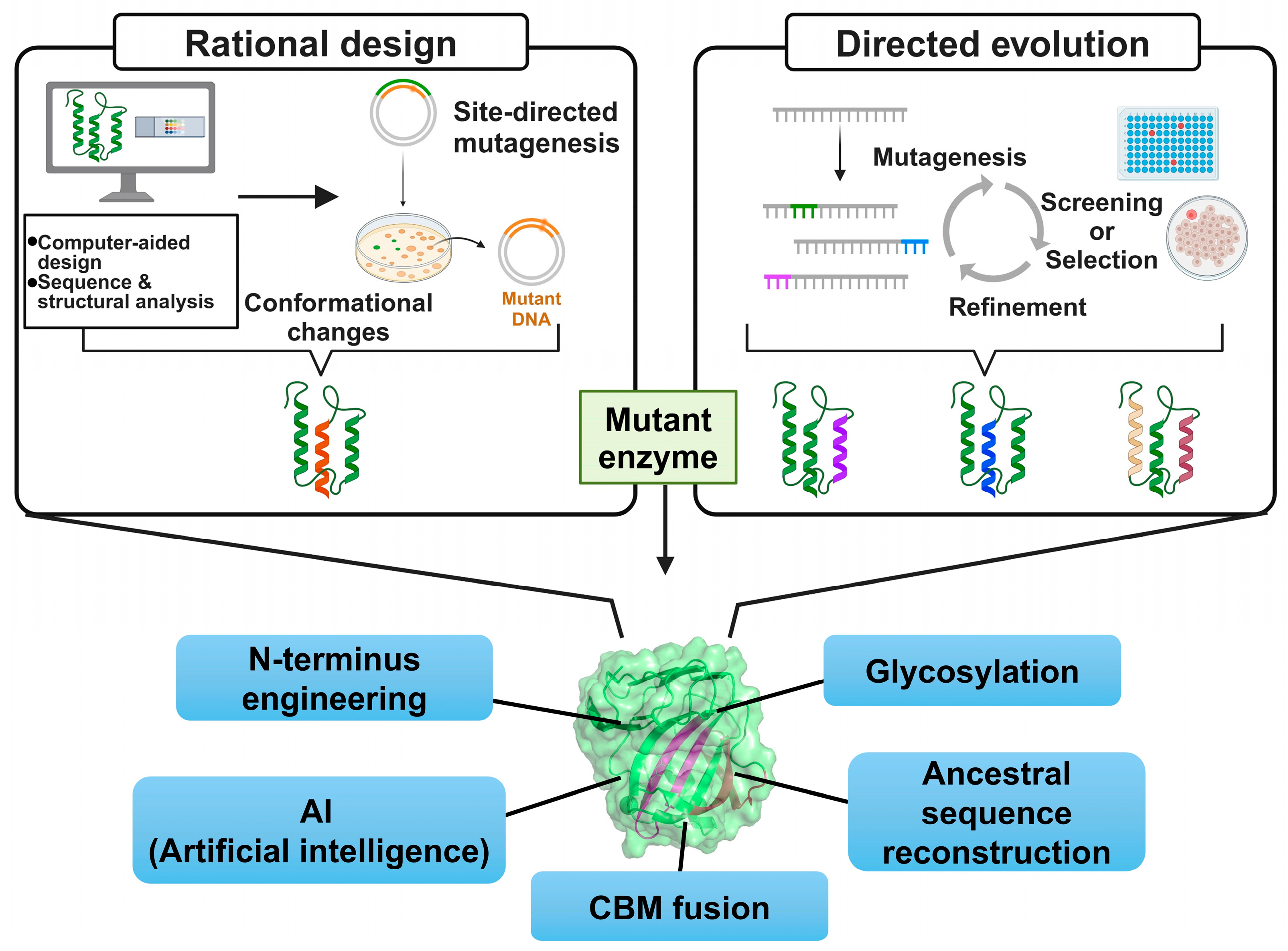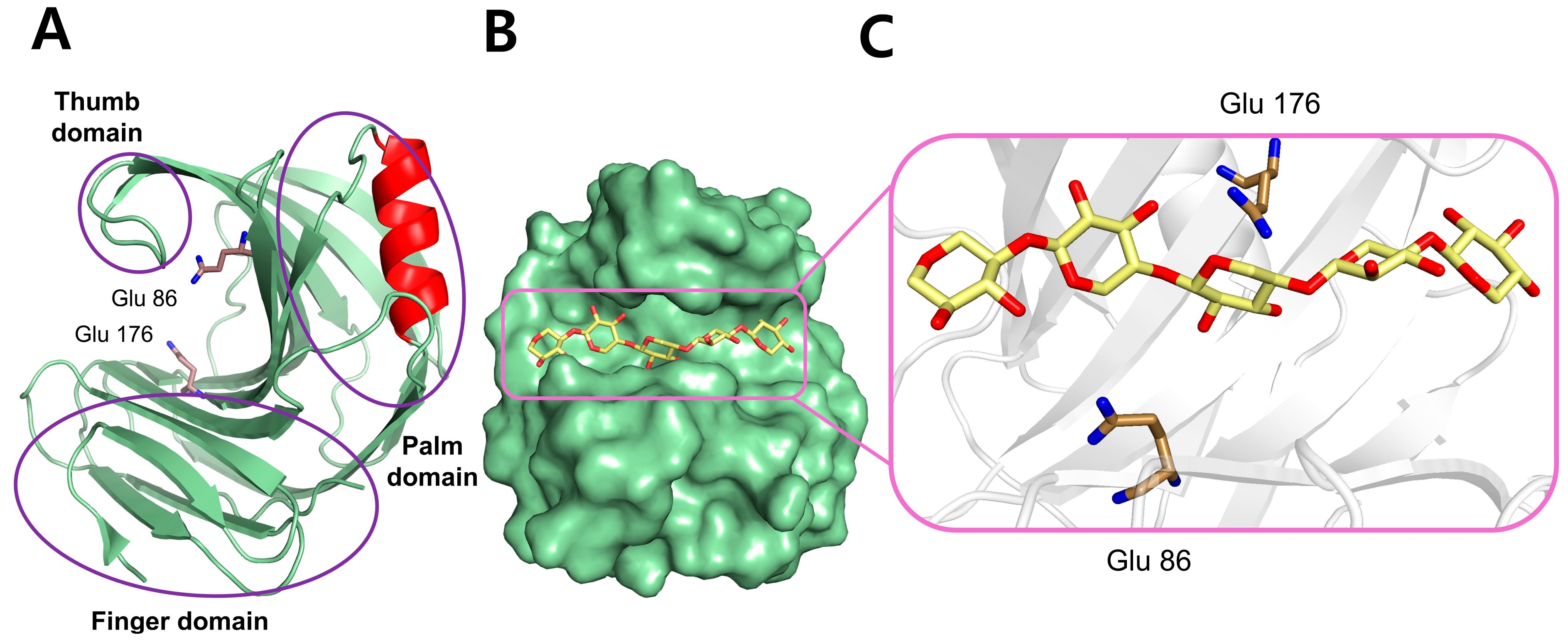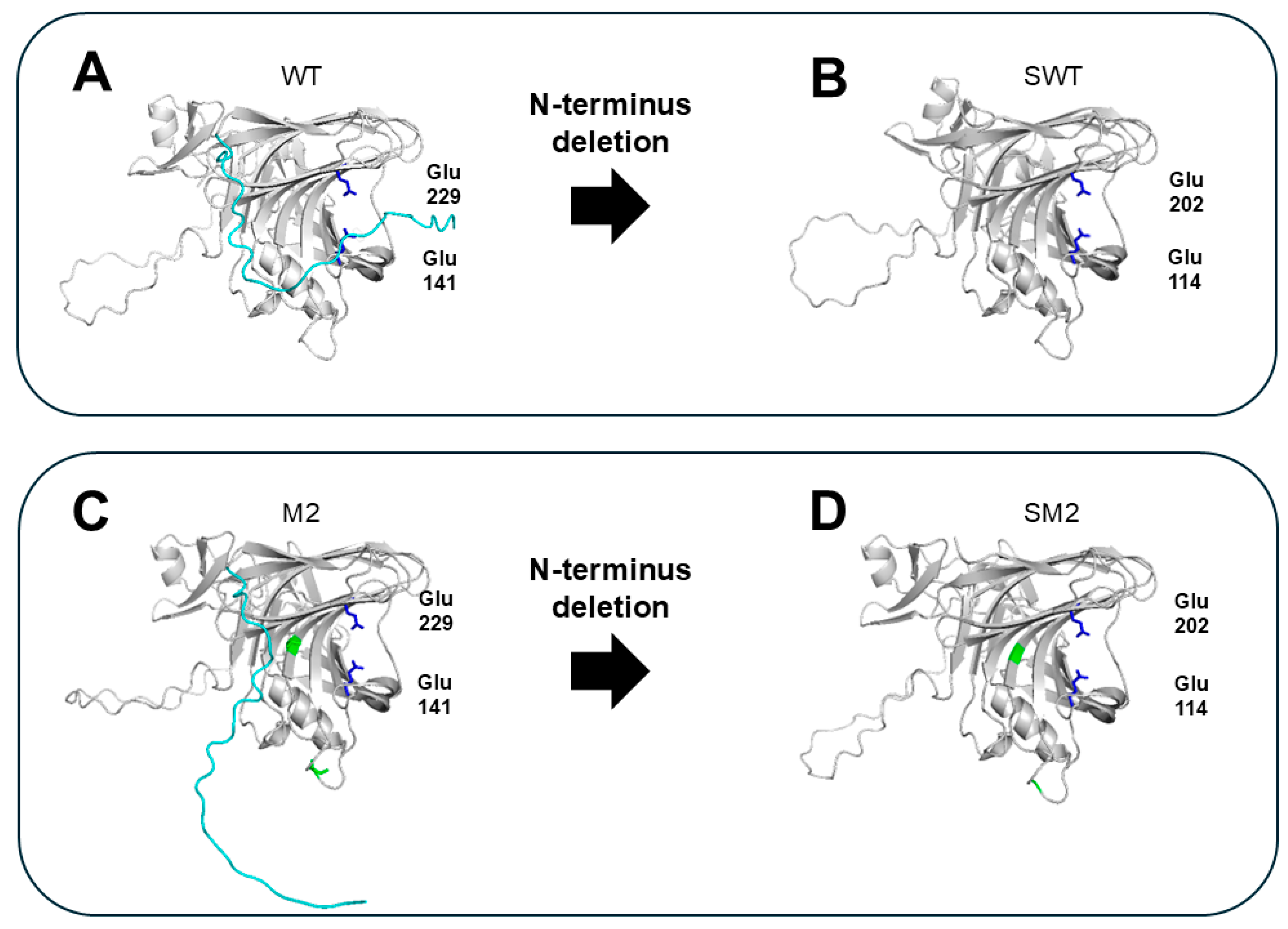Strategies and Recent Trends in Engineering Thermostable GH11 Xylanases
Abstract
:1. Introduction
2. Structure and Reaction Mechanism of GH11 Xylanases
3. Protein Engineering Strategies for GH11 Xylanases
3.1. N-Terminal Engineering
3.1.1. N-Terminal Deletion
3.1.2. N-Terminal Substitution
3.1.3. N-Terminal Extension
3.2. Chimera Construction
3.3. Glycosylation
4. Recent Advances
4.1. AI Technologies
4.2. Ancestral Sequence Reconstruction
5. Conclusions
Author Contributions
Funding
Data Availability Statement
Acknowledgments
Conflicts of Interest
References
- Gault, S.; Higgins, P.M.; Cockell, C.S.; Gillies, K. A meta-analysis of the activiy, stability, and mutational characteristics of temperature-adapted enzymes. Biosci. Rep. 2021, 41, BSR20210336. [Google Scholar] [CrossRef]
- Bornscheuer, U.T.; Huisman, G.W.; Kazlauskas, R.J.; Lutz, S.; Moore, J.C.; Robins, K. Engineering the third wave of biocatalysis. Nature 2012, 485, 185–194. [Google Scholar] [CrossRef]
- Deng, L.; Li, C.; Lan, Y.; Sun, G.; Shang, C. Differential evolution with dynamic combination based mutation operator and two-level parameter adaptation strategy. Expert Syst. Appl. 2022, 192, 116298. [Google Scholar] [CrossRef]
- Wu, S.; Snajdrova, R.; Moore, J.C.; Baldenius, K.; Bornscheuer, U.T. Biocatalysis: Enzymatic synthesis for industrial applications. Angew. Chem. Int. Ed. 2020, 60, 88–119. [Google Scholar] [CrossRef]
- Ao, Y.F.; Dörr, M.; Menke, M.J.; Born, S.; Heuson, E.; Bornscheuer, U.T. Data-Driven protein engineering for improving catalytic activity and selectivity. ChemBioChem 2023, 25, e202300754. [Google Scholar] [CrossRef] [PubMed]
- Jumper, J.; Evans, R.; Pritzel, A.; Green, T.; Figurnov, M.; Ronneberger, O.; Tunyasuvunakool, K.; Bates, R.; Žídek, A.; Potapenko, A.; et al. Highly accurate protein structure prediction with AlphaFold. Nature 2021, 596, 583–589. [Google Scholar] [CrossRef] [PubMed]
- Nam, K.H. Recognition of a Single β-D-xylopyranose molecule by xylanase GH11 from Thermoanaerobacterium saccharolyticum. Crystals 2024, 14, 402. [Google Scholar] [CrossRef]
- Kim, I.J.; Kim, S.R.; Kim, K.H.; Bornscheuer, U.T.; Nam, K.H. Characterization and structural analysis of the endo-1,4-β-xylanase GH11 from the hemicellulose-degrading Thermoanaerobacterium saccharolyticum useful for lignocellulose saccharification. Sci. Rep. 2023, 13, 17332. [Google Scholar] [CrossRef]
- Briganti, L.; Capetti, C.; Pellegrini, V.O.A.; Ghio, S.; Campos, E.; Nascimento, A.S.; Polikarpov, I. Structural and molecular dynamics investigations of ligand stabilization via secondary binding site interactions in Paenibacillus xylanivorans GH11 xylanase. Comput. Struct. Biotechnol. J. 2021, 19, 1557–1566. [Google Scholar] [CrossRef]
- Kazlauskas, R. Engineering more stable proteins. Chem. Soc. Rev. 2018, 47, 9026–9045. [Google Scholar] [CrossRef]
- Han, N.; Ma, Y.; Mu, Y.; Tang, X.; Li, J.; Huang, Z. Enhancing thermal tolerance of a fungal GH11 xylanase guided by B-factor analysis and multiple sequence alignment. Enzym. Microb. Technol. 2019, 131, 109422. [Google Scholar] [CrossRef]
- Bu, Y.; Cui, Y.; Peng, Y.; Hu, M.; Tian, Y.e.; Tao, Y.; Wu, B. Engineering improved thermostability of the GH11 xylanase from Neocallimastix patriciarum via computational library design. Appl. Microbiol. Biotechnol. 2018, 102, 3675–3685. [Google Scholar] [CrossRef]
- Han, N.; Miao, H.; Ding, J.; Li, J.; Mu, Y.; Zhou, J.; Huang, Z. Improving the thermostability of a fungal GH11 xylanase via site-directed mutagenesis guided by sequence and structural analysis. Biotechnol. Biofuels 2017, 10, 133. [Google Scholar] [CrossRef]
- Li, Q.; Wu, T.; Duan, Y.; Pei, J.; Zhao, L. Improving the thermostability and pH stability of Aspergillus niger xylanase by site-directed mutagenesis. Appl. Biochem. Microbiol. 2019, 55, 136–144. [Google Scholar] [CrossRef]
- Tian, W.; Zhang, Z.; Yang, C.; Li, P.; Xiao, J.; Wang, R.; Du, P.; Li, N.; Wang, J. Engineering mesophilic GH11 xylanase from Cellulomonas flavigena by rational design of N-terminus substitution. Front. Bioeng. Biotechnol. 2022, 10, 1044291. [Google Scholar] [CrossRef]
- Li, T.; Yang, S.; Wang, X.; Cai, H.; Wang, Y.; Li, C.; Li, E. Improving thermostability of GH11 xylanase XynASP by the design of loop region. Crystals 2022, 12, 1228. [Google Scholar] [CrossRef]
- Yang, Y.; Zhang, C.; Lu, H.; Wu, Q.; Wu, Y.; Li, W.; Li, X. Improvement of thermostability and catalytic efficiency of xylanase from Myceliophthora thermophilar by N-terminal and C-terminal truncation. Front. Microbiol. 2024, 15, 1385329. [Google Scholar] [CrossRef]
- Hokanson, C.A.; Cappuccilli, G.; Odineca, T.; Bozic, M.; Behnke, C.A.; Mendez, M.; Coleman, W.J.; Crea, R. Engineering highly thermostable xylanase variants using an enhanced combinatorial library method. Protein Eng. Des. Sel. 2011, 24, 597–605. [Google Scholar] [CrossRef]
- Ruller, R.; Alponti, J.; Deliberto, L.A.; Zanphorlin, L.M.; Machado, C.B.; Ward, R.J. Concommitant adaptation of a GH11 xylanase by directed evolution to create an alkali-tolerant/thermophilic enzyme. Protein Eng. Des. Sel. 2014, 27, 255–262. [Google Scholar] [CrossRef]
- Wu, Q.; Zhang, C.; Dong, W.; Lu, H.; Yang, Y.; Li, W.; Xu, Y.; Li, X. Simultaneously enhanced thermostability and catalytic activity of xylanase from Streptomyces rameus L2001 by rigidifying flexible regions in loop regions of the N-terminus. J. Agric. Food Chem. 2023, 71, 12785–12796. [Google Scholar] [CrossRef]
- Jänis, J.; Turunen, O.; Leisola, M.; Derrick, P.J.; Rouvinen, J.; Vainiotalo, P. Characterization of mutant xylanases using fourier transform ion cyclotron resonance mass spectrometry: Stabilizing contributions of disulfide bridges and N-terminal extensions. Biochemistry 2004, 43, 9556–9566. [Google Scholar] [CrossRef] [PubMed]
- Purmonen, M.; Valjakka, J.; Takkinen, K.; Laitinen, T.; Rouvinen, J. Molecular dynamics studies on the thermostability of family 11 xylanases. Protein Eng. Des. Sel. 2007, 20, 551–559. [Google Scholar] [CrossRef] [PubMed]
- Ventorim, R.Z.; de Oliveira Mendes, T.A.; Trevizano, L.M.; dos Santos Camargos, A.M.; Guimarães, V.M. Impact of the removal of N-terminal non-structured amino acids on activity and stability of xylanases from Orpinomyces sp. PC-2. Int. J. Biol. Macromol. 2018, 106, 312–319. [Google Scholar] [CrossRef] [PubMed]
- Permyakov, E.A.; Liu, L.; Sun, X.; Yan, P.; Wang, L.; Chen, H. Non-structured amino-acid impact on GH11 differs from GH10 Xylanase. PLoS ONE 2012, 7, e45762. [Google Scholar] [CrossRef]
- Bhat, S.K.; Purushothaman, K.; Kini, K.R.; Gopala Rao Appu Rao, A.R. Design of mutants of GH11 xylanase from Bacillus pumilus for enhanced stability by amino acid substitutions in the N-terminal region: An in silico analysis. J. Biomol. Struct. Dyn. 2021, 40, 7666–7679. [Google Scholar] [CrossRef]
- Song, L.; Dumon, C.; Siguier, B.; André, I.; Eneyskaya, E.; Kulminskaya, A.; Bozonnet, S.; O’Donohue, M.J. Impact of an N-terminal extension on the stability and activity of the GH11 xylanase from Thermobacillus xylanilyticus. J. Biotechnol. 2014, 174, 64–72. [Google Scholar] [CrossRef] [PubMed]
- Wu, Q.; Zhang, C.; Zhu, W.; Lu, H.; Li, X.; Yang, Y.; Xu, Y.; Li, W. Improved thermostability, acid tolerance as well as catalytic efficiency of Streptomyces rameus L2001 GH11 xylanase by N-terminal replacement. Enzym. Microb. Technol. 2023, 162, 110143. [Google Scholar] [CrossRef]
- Li, Y.; Li, C.; Huang, H.; Rao, S.; Zhang, Q.; Zhou, J.; Li, J.; Du, G.; Liu, S. Significantly enhanced thermostability of Aspergillus niger xylanase by modifying Its highly flexible regions. J. Agric. Food Chem. 2022, 70, 4620–4630. [Google Scholar] [CrossRef]
- Hofmann, A.; Bhardwaj, A.; Leelavathi, S.; Mazumdar-Leighton, S.; Ghosh, A.; Ramakumar, S.; Reddy, V.S. The critical role of N- and C-terminal contact in protein stability and folding of a family 10 xylanase under extreme conditions. PLoS ONE 2010, 5, e11347. [Google Scholar] [CrossRef]
- Mahanta, P.; Bhardwaj, A.; Kumar, K.; Reddy, V.S.; Ramakumar, S. Structural insights intoN-terminal to C-terminal interactions and implications for thermostability of a (β/α)8-triosephosphate isomerase barrel enzyme. FEBS J. 2015, 282, 3543–3555. [Google Scholar] [CrossRef]
- Zhang, H.; Li, J.; Wang, J.; Yang, Y.; Wu, M. Determinants for the improved thermostability of a mesophilic family 11 xylanase predicted by computational methods. Biotechnol. Biofuels Bioprod. 2014, 7, 3. [Google Scholar] [CrossRef]
- Wang, L.; Wang, Y.; Chang, S.; Gao, Z.; Ma, J.; Wu, B.; He, B.; Wei, P. Identification and characterization of a thermostable GH11 xylanase from Paenibacillus campinasensis NTU-11 and the distinct roles of its carbohydrate-binding domain and linker sequence. Colloids Surf. B Biointerfaces 2022, 209, 112167. [Google Scholar] [CrossRef]
- Lombard, V.; Golaconda Ramulu, H.; Drula, E.; Coutinho, P.M.; Henrissat, B. The carbohydrate-active enzymes database (CAZy) in 2013. Nucleic Acids Res. 2014, 42, D490–D495. [Google Scholar] [CrossRef] [PubMed]
- Hao, M.-S.; Mazurkewich, S.; Li, H.; Kvammen, A.; Saha, S.; Koskela, S.; Inman, A.R.; Nakajima, M.; Tanaka, N.; Nakai, H.; et al. Structural and biochemical analysis of family 92 carbohydrate-binding modules uncovers multivalent binding to β-glucans. Nat. Commun. 2024, 15, 3429. [Google Scholar] [CrossRef] [PubMed]
- Kim, I.J.; Lee, H.J.; Choi, I.-G.; Kim, K.H. Synergistic proteins for the enhanced enzymatic hydrolysis of cellulose by cellulase. Appl. Microbiol. Biotechnol. 2014, 98, 8469–8480. [Google Scholar] [CrossRef]
- Kim, I.J.; Ko, H.J.; Kim, T.W.; Choi, I.G.; Kim, K.H. Characteristics of the binding of a bacterial expansin (BsEXLX1) to microcrystalline cellulose. Biotechnol. Bioeng. 2012, 110, 401–407. [Google Scholar] [CrossRef]
- Krska, D.; Mazurkewich, S.; Brown, H.A.; Theibich, Y.; Poulsen, J.-C.N.; Morris, A.L.; Koropatkin, N.M.; Lo Leggio, L.; Larsbrink, J. Structural and functional analysis of a multimodular hyperthermostable xylanase-glucuronoyl esterase from Caldicellulosiruptor kristjansonii. Biochemistry 2021, 60, 2206–2220. [Google Scholar] [CrossRef]
- You, Y.; Kong, H.; Li, C.; Gu, Z.; Ban, X.; Li, Z. Carbohydrate binding modules: Compact yet potent accessories in the specific substrate binding and performance evolution of carbohydrate-active enzymes. Biotechnol. Adv. 2024, 73, 108365. [Google Scholar] [CrossRef]
- Miao, H.; Ma, Y.; Zhe, Y.; Tang, X.; Wu, Q.; Huang, Z.; Han, N. Improving the thermostability of a fungal GH11 xylanase via fusion of a submodule (C2) from Hyperthermophilic CBM9_1-2. Int. J. Mol. Sci. 2021, 23, 463. [Google Scholar] [CrossRef]
- Jun, H.; Bing, Y.; Keying, Z.; Xuemei, D.; Daiwen, C. Thermostable carbohydrate binding module increases the thermostability and substrate-binding capacity of Trichoderma reesei xylanase 2. New Biotechnol. 2009, 26, 53–59. [Google Scholar] [CrossRef]
- Liu, L.; Zeng, L.; Wang, S.; Cheng, J.; Li, X.; Song, A.; Wu, K.; Chen, H. Activity and thermostability increase of xylanase following transplantation with modules sub-divided from hyper-thermophilic CBM9_1-2. Process Biochem. 2012, 47, 853–857. [Google Scholar] [CrossRef]
- Mamo, G.; Hatti-Kaul, R.; Mattiasson, B. Fusion of carbohydrate binding modules from Thermotoga neapolitana with a family 10 xylanase from Bacillus halodurans S7. Extremophiles 2006, 11, 169–177. [Google Scholar] [CrossRef] [PubMed]
- Forsberg, Z.; Stepnov, A.A.; Tesei, G.; Wang, Y.; Buchinger, E.; Kristiansen, S.K.; Aachmann, F.L.; Arleth, L.; Eijsink, V.G.H.; Lindorff-Larsen, K.; et al. The effect of linker conformation on performance and stability of a two-domain lytic polysaccharide monooxygenase. J. Biol. Chem. 2023, 299, 105262. [Google Scholar] [CrossRef]
- Pandey, C.; Sharma, P.; Gupta, N. Engineering to enhance thermostability of xylanase: For the new era of biotechnology. J. Appl. Biol. Biotechnol. 2022, 11, 41–54. [Google Scholar] [CrossRef]
- Yang, A.; Cheng, J.; Liu, M.; Shangguan, Y.; Liu, L. Sandwich fusion of CBM9_2 to enhance xylanase thermostability and activity. Int. J. Biol. Macromol. 2018, 117, 586–591. [Google Scholar] [CrossRef]
- Han, C.; Wang, Q.; Sun, Y.; Yang, R.; Liu, M.; Wang, S.; Liu, Y.; Zhou, L.; Li, D. Improvement of the catalytic activity and thermostability of a hyperthermostable endoglucanase by optimizing N-glycosylation sites. Biotechnol. Biofuels 2020, 13, 30. [Google Scholar] [CrossRef]
- Ramakrishnan, K.; Johnson, R.L.; Winter, S.D.; Worthy, H.L.; Thomas, C.; Humer, D.C.; Spadiut, O.; Hindson, S.H.; Wells, S.; Barratt, A.H.; et al. Glycosylation increases active site rigidity leading to improved enzyme stability and turnover. FEBS J. 2023, 290, 3812–3827. [Google Scholar] [CrossRef] [PubMed]
- Varki, A. Biological roles of glycans. Glycobiology 2017, 27, 3–49. [Google Scholar] [CrossRef]
- Fonseca-Maldonado, R.; Vieira, D.S.; Alponti, J.S.; Bonneil, E.; Thibault, P.; Ward, R.J. Engineering the pattern of protein glycosylation modulates the thermostability of a GH11 xylanase. J. Biol. Chem. 2013, 288, 25522–25534. [Google Scholar] [CrossRef]
- Nam, K.H. Real-time monitoring of large-scale crystal growth using batch crystallization for serial crystallography. J. Cryst. Growth 2023, 614, 127219. [Google Scholar] [CrossRef]
- Yang, J.; Li, F.-Z.; Arnold, F.H. Opportunities and challenges for machine learning-assisted enzyme engineering. ACS Cent. Sci. 2024, 10, 226–241. [Google Scholar] [CrossRef]
- Foroozandeh Shahraki, M.; Farhadyar, K.; Kavousi, K.; Azarabad, M.H.; Boroomand, A.; Ariaeenejad, S.; Hosseini Salekdeh, G. A generalized machine-learning aided method for targeted identification of industrial enzymes from metagenome: A xylanase temperature dependence case study. Biotechnol. Bioeng. 2020, 118, 759–769. [Google Scholar] [CrossRef] [PubMed]
- Pinto, G.P.; Corbella, M.; Demkiv, A.O.; Kamerlin, S.C.L. Exploiting enzyme evolution for computational protein design. Trends Biochem. Sci. 2022, 47, 375–389. [Google Scholar] [CrossRef] [PubMed]
- Ngo, K.; Bruno da Silva, F.; Leite, V.B.P.; Contessoto, V.G.; Onuchic, J.N. Improving the thermostability of xylanase a from Bacillus subtilis by combining bioinformatics and electrostatic interactions optimization. J. Phys. Chem. B 2021, 125, 4359–4367. [Google Scholar] [CrossRef] [PubMed]
- Sun, D.; Qi, H.; Dou, G.; Mao, S.; Lu, F.; Tian, K.; Qin, H.-M. Ancestral sequence reconstruction of a robust β-1,4-xylanase and efficient expression in Bacillus subtilis. Int. J. Biol. Macromol. 2024, 282, 137188. [Google Scholar] [CrossRef]
- Hu, G.; Hong, X.; Zhu, M.; Lei, L.; Han, Z.; Meng, Y.; Yang, J. Improving the quality of wheat flour bread by a thermophilic xylanase with ultra activity and stability reconstructed by ancestral sequence and computational-aided analysis. Molecules 2024, 29, 1895. [Google Scholar] [CrossRef]





| Enzyme (Wild-Type) | Source | Thermal Properties c | Potential Mechanism | Engineering Strategy | Reference |
|---|---|---|---|---|---|
| XynCDBFV | Neocallimastix patriciarum | · Optimal temp. : 55 °C → 65 °C · Tm : 14 °C↑ | Enhanced hydrophobic interactions among the β-sheet clusters | · In silico analysis using FRESCO (RD a) · 4 substitutions d | [12] |
| · Residual activity : 14%↑ at 80 °C and 1 h | C-terminal stabilization through increased hydrogen bonding | · C-terminus substitution (RD a) · 3 substitutions d | [13] | ||
| MxynB | Aspergillus niger | · Optimal temp. : 40 °C → 50 °C · Residual activity : 570%↑ at 70 °C and 1 h | Disulfide bond formation and enhanced charge-hydrophobic interactions | Disulfide bond introduction (RD a) · 2 substitutions d | [14] |
| CFXyl3 | Cellulomonas flavigena | · Optimal temp. : 55 °C → 85 °C · Residual activity : 40% at 30 min → 80% at 150 min (70 °C) · Tm : 34.5↑ | Added hydrophobic interactions, salt bridges, and aromatic interactions | N-terminus replacement (RD a) | [15] |
| XynASP | Aspergillus saccharolyticus | · Optimal temp. : 45 °C → 55 °C · t1/2 : 20.7 min → 127 min at 45 °C · Residual activity : <20% → >50% at 45 °C and 2 h | Reduced structural flexibility via new hydrophobic contacts and hydrogen bonds in the loop | · Loop engineering · In silico analysis using FireProt (RD a) · 3 substitutions d | [16] |
| Mtxylan2 | Myceliophthora thermophila | · Optimal temp. 65 °C → 70 °C · Residual activity : 30% → >80% at 65 °C | · Changes in H-bonding · Increased hydrophobicity · Modified surface charge | N-terminal and C-terminal truncation (RD a) | [17] |
| BD-11 | Trichoderma reesei | · Tm : 57.5 → 64.8 °C | Interchanging hydrophobic and hydrophilic residues | · Look-Through Mutagenesis · Combinatorial Beneficial Mutagenesis (DE b) · 4 substitutions d | [18] |
| XynA | Bacillus subtilis | · Optimal temp. : 55 °C → 80 °C · t1/2 : <2 min → 60 min at 80 °C | · Modulation of protein-solvent interaction · Decrease in specific heat capacity · Altered packing in hydrophobic core | · Error-prone PCR · DNA shuffling (DE b) · 8 substitutions d | [19] |
| Enzyme (Wild-Type) | Source | Thermal Stability | Strategy | Reference |
|---|---|---|---|---|
| CDBFV | Neocallimastix patriciarum | · t1/2 : 4.9-fold ↑ | Insertion of the C2 submodule from CBM9_1-2 into the N- or C-terminus | [44] |
| XynNTU | Paenibacillus campinasensis NTU-11 | · Residual activity : 58.4% → 91.4% at 60 °C and 48 h | Truncation of the CBM6 and linker regions. | [32] |
| Xyn | Aspergillus niger | · t1/2 : 0.35 h → 8.69 h at 50 °C : 0.35 h → 2.85 h at 80 °C · Tm : 1.8 °C ↑ | Sandwich fusion of CBM both N- and C-termini | [45] |
| Xyn | Aspergillus niger | · t1/2 : 17.6 min → 69.3 min at 50 °C | Transplantation of the submodules of CBM9 1-2 | [41] |
| Xyn2 | Trichoderma reesei | · Residual activity : 40% → >85% at 60 °C and 30 min | Genetic fusion of the thermostabilizing domain (A2) to N-terminus | [40] |
Disclaimer/Publisher’s Note: The statements, opinions and data contained in all publications are solely those of the individual author(s) and contributor(s) and not of MDPI and/or the editor(s). MDPI and/or the editor(s) disclaim responsibility for any injury to people or property resulting from any ideas, methods, instructions or products referred to in the content. |
© 2025 by the authors. Licensee MDPI, Basel, Switzerland. This article is an open access article distributed under the terms and conditions of the Creative Commons Attribution (CC BY) license (https://creativecommons.org/licenses/by/4.0/).
Share and Cite
Kim, B.S.; Kim, I.J. Strategies and Recent Trends in Engineering Thermostable GH11 Xylanases. Catalysts 2025, 15, 317. https://doi.org/10.3390/catal15040317
Kim BS, Kim IJ. Strategies and Recent Trends in Engineering Thermostable GH11 Xylanases. Catalysts. 2025; 15(4):317. https://doi.org/10.3390/catal15040317
Chicago/Turabian StyleKim, Beom Soo, and In Jung Kim. 2025. "Strategies and Recent Trends in Engineering Thermostable GH11 Xylanases" Catalysts 15, no. 4: 317. https://doi.org/10.3390/catal15040317
APA StyleKim, B. S., & Kim, I. J. (2025). Strategies and Recent Trends in Engineering Thermostable GH11 Xylanases. Catalysts, 15(4), 317. https://doi.org/10.3390/catal15040317







